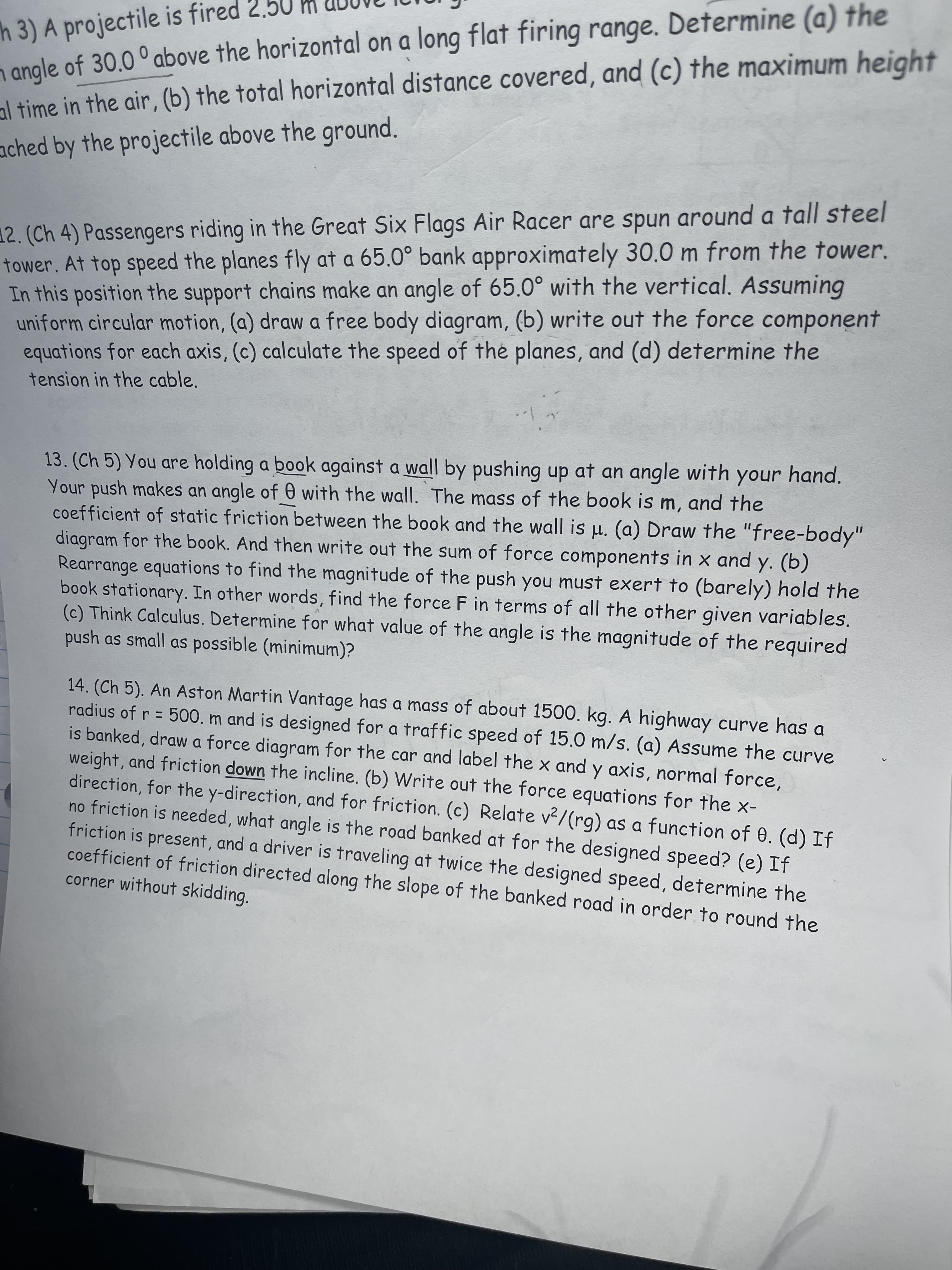13. (Ch 5) You are holding a book against a wall by pushing up at an angle with your hand. Your push makes an angle of 0 with the wall. The mass of the book is m, and the coefficient of static friction between the book and the wall is u. (a) Draw the "free-body" diagram for the book. And then write out the sum of force components in x and y. (b) Rearrange equations to find the magnitude of the push you must exert to (barely) hold the book stationary. In other words, find the force F in terms of all the other given variables. (c) Think Calculus. Determine for what value of the angle is the magnitude of the required push as small as possible (minimum)?
13. (Ch 5) You are holding a book against a wall by pushing up at an angle with your hand. Your push makes an angle of 0 with the wall. The mass of the book is m, and the coefficient of static friction between the book and the wall is u. (a) Draw the "free-body" diagram for the book. And then write out the sum of force components in x and y. (b) Rearrange equations to find the magnitude of the push you must exert to (barely) hold the book stationary. In other words, find the force F in terms of all the other given variables. (c) Think Calculus. Determine for what value of the angle is the magnitude of the required push as small as possible (minimum)?
Principles of Physics: A Calculus-Based Text
5th Edition
ISBN:9781133104261
Author:Raymond A. Serway, John W. Jewett
Publisher:Raymond A. Serway, John W. Jewett
Chapter3: Motion In Two Dimensions
Section: Chapter Questions
Problem 9P
Related questions
Topic Video
Question
Question 13
solve

Transcribed Image Text:h 3) A projectile is fired 2.5
n angle of 30.0 ° above the horizontal on a long flat firing range. Determine (a) the
al time in the air, (b) the total horizontal distance covered, and (c) the maximum height
ached by the projectile above the ground.
12. (Ch 4) Passengers riding in the Great Six Flags Air Racer are spun around a tall steel
tower. At top speed the planes fly at a 65.0° bank approximately 30.0 m from the tower.
In this position the support chains make an angle of 65.0° with the vertical. Assuming
uniform circular motion, (a) draw a free body diagram, (b) write out the force component
equations for each axis, (c) calculate the speed of the planes, and (d) determine the
tension in the cable.
13. (Ch 5) You are holding a book against a wall by pushing up at an angle with your hand.
Your push makes an angle of 0 with the wall. The mass of the book is m, and the
coefficient of static friction between the book and the wall is µ. (a) Draw the "free-body"
diagram for the book. And then write out the sum of force components in x and y. (b)
Rearrange equations to find the magnitude of the push you must exert to (barely) hold the
book stationary. In other words, find the force F in terms of all the other given variables.
(c) Think Calculus. Determine for what value of the angle is the magnitude of the required
push as small as possible (minimum)?
14. (Ch 5). An Aston Martin Vantage has a mass of about 1500. kg. A highway curve has a
radius of r = 500. m and is designed for a traffic speed of 15.0 m/s. (a) Assume the curve
is banked, draw a force diagram for the car and label the x and y axis, normal force,
weight, and friction down the incline. (b) Write out the force equations for the x-
direction, for the y-direction, and for friction. (c) Relate v2/(rg) as a function of 0. (d) If
no friction is needed, what angle is the road banked at for the designed speed? (e) If
friction is present, and a driver is traveling at twice the designed speed, determine the
coefficient of friction directed along the slope of the banked road in order to round the
corner without skidding.
Expert Solution
This question has been solved!
Explore an expertly crafted, step-by-step solution for a thorough understanding of key concepts.
This is a popular solution!
Trending now
This is a popular solution!
Step by step
Solved in 4 steps with 1 images

Knowledge Booster
Learn more about
Need a deep-dive on the concept behind this application? Look no further. Learn more about this topic, physics and related others by exploring similar questions and additional content below.Recommended textbooks for you

Principles of Physics: A Calculus-Based Text
Physics
ISBN:
9781133104261
Author:
Raymond A. Serway, John W. Jewett
Publisher:
Cengage Learning

Principles of Physics: A Calculus-Based Text
Physics
ISBN:
9781133104261
Author:
Raymond A. Serway, John W. Jewett
Publisher:
Cengage Learning